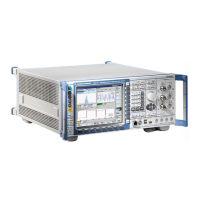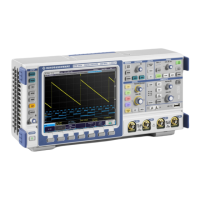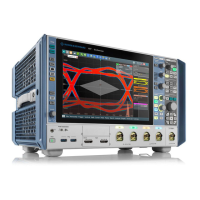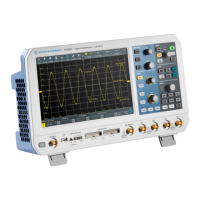CMU Instrument Design and Function Description
1100.4903.82 3.11 E-4
frequency by means of triple signal conversion (IF3, IF2, IF1). This is
necessary to obtain a high image-frequency rejection.
At the TX output, a switchable attenuator with fine stepping and large
attenuation range is used to set the RF signal amplitude according to
the level selected.
The RF signal is finally taken to the RF FRONTEND at the SMA
connector RFTX1 (bottom of module).
The transmitter side is provided with an extra LO1TX (Local Oscillator)
with large tuning range and very fine frequency resolution used for
setting the desired transmitter frequency, an LO2 fixed-frequency
oscillator shared with the receiver side and an extra LO3TX with small
tuning range. All LOs are synchronized by the MMCX connector
110.8MHz at the bottom of the module with the reference frequency
from the REFERENCE BOARD.
Besides, an MMCX connector at the top of the RXTX BOARD1 is
designed as input with the second transmitter IF (RESIF2TX) which is
activated via software switches.
Receiver functions
On the receiver side (RX), the RF signal is fed in at the SMA connector
RFRX1 (bottom of module) of the RXTX BOARD1 which is provided by
the RF FRONTEND.
On the RXTX BOARD1, this signal is taken via a switchable attenuator
with fine stepping and large attenuation range in order to match the
level according to the level applied.
Subsequently, this signal is converted to an IF frequency of 10.7 MHz
by means of triple signal conversion (IF1, IF2, IF3) and several filter
and amplifier stages and provided at the MMCX connector IF3RX1 (top
of module) for the DIGITAL BOARD.
This procedure is necessary to achieve a high image-frequency
rejection and a high dynamic range with a simultaneously high
intermodulation suppression.
For the receiver side, an extra LO1RX (local oscillator) is provided with
a large tuning range and a very fine frequency resolution used for
setting the receive frequency, an LO2 fixed-frequency oscillator shared
with the transmitter and an extra LO3RX with a very small tuning
range.
All LOs are synchronized by the MMCX connector 110.8 MHz at the
bottom of the module with the reference frequency from the
REFERENCE BOARD.
A further MMCX connector RESIF3RX (top of module) provides a
buffered RX IF signal of 10.7 MHz which is taken to the rear of the
CMU via a coax cable. This signal output can be activated via a
software switch.
Besides, an MMCX connector at the top of the RXTX BOARD1 is
designed as output with the second receiver IF (RESIF2RX) which can
be activated via software switches.
Correction processor
The RXTX BOARD1 contains an extra correction processor with large
flash PROM.
It controls all the static and dynamic settings on the RXTX BOARD1
and, as a special feature, also the attenuator pads and amplifiers of the
RX and TX attenuator on the RF FRONTEND.
Besides, the correction processor permits to read out the individual
module error data from the EEPROMS of the respective modules in a
so-called correction procedure (automatic module data adjustment)
and calculate the deviations for all possible signal paths. These

